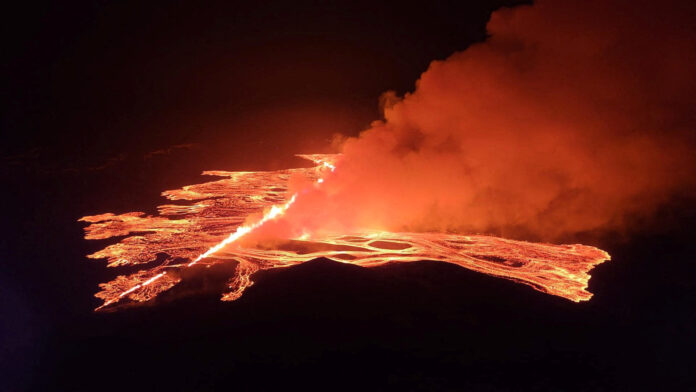The Reykjanes Peninsula in Iceland has been gripped by yet another volcanic eruption, marking the fourth such event since December, according to an announcement from the Icelandic Met Office (IMO). The eruption, situated between Stora Skogfell and Hagafell, has unleashed streams of glowing lava and billowing smoke, as captured in live video footage.
A state of emergency has been declared in southern Iceland as the eruption intensifies, believed to be the most potent eruption in the recent series. Lava has breached the eastern defenses near the evacuated town of Grindavik, prompting the relocation of nearby residents and visitors, including those from the renowned Blue Lagoon, a popular tourist destination.
Despite the volcanic activity, Iceland’s airspace remains open, although a significant lava spill continues to emit smoke into the atmosphere. The eruption, which commenced around 20:00 local time on Saturday, has drawn comparisons to the previous eruption that occurred on December 8, unfolding in a similar location.
The lava flow, significantly broader than previous occurrences, poses concerns for infrastructure, particularly fiber optic cables vital for communication services. Protective embankments have been constructed to mitigate potential damage, as confirmed by Rikke Pedersen, head of the Reykjavik-based Nordic Volcanological Centre.
In Grindavik, between five to ten homes have been evacuated, adding to the challenges faced by residents who recently returned after an eruption in January caused widespread destruction. Despite the risks, many have opted not to return to their homes, highlighting the ongoing impact of volcanic activity on local communities.
Iceland’s geological landscape, with 33 active volcano systems, sits atop the Mid-Atlantic Ridge, a significant tectonic boundary. Scientists posit that the Reykjanes Peninsula is entering a new phase of volcanic activity, potentially lasting for decades or even centuries, with this latest eruption marking the seventh since 2021.
The last significant period of volcanic activity in the region occurred 800 years ago, underscoring the unpredictable nature of Iceland’s volcanic landscape and the enduring resilience of its inhabitants in the face of natural upheaval.



